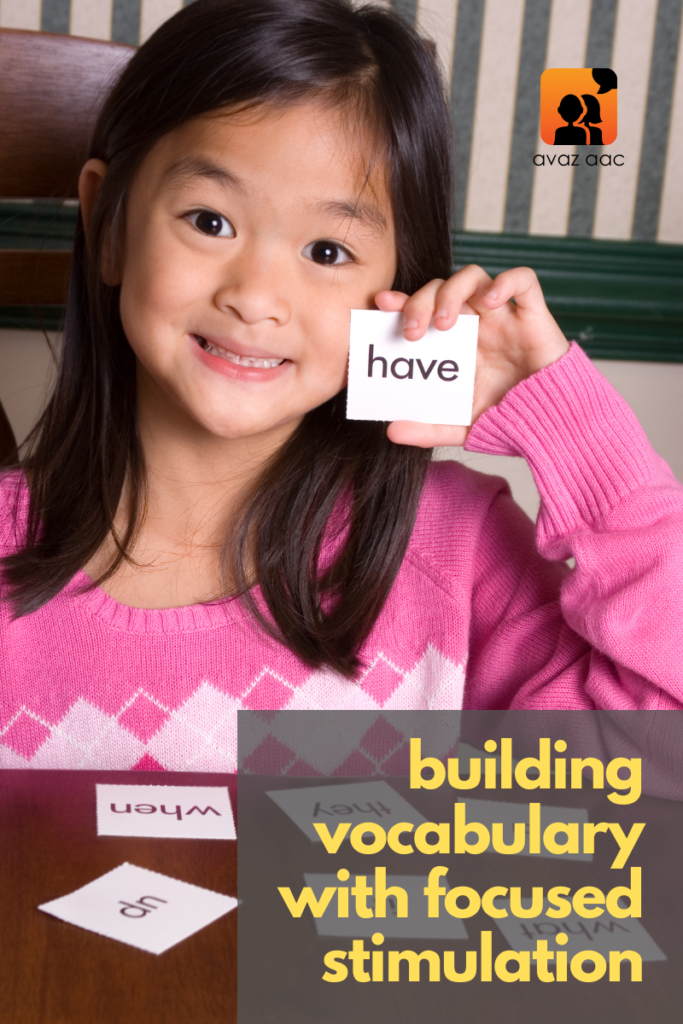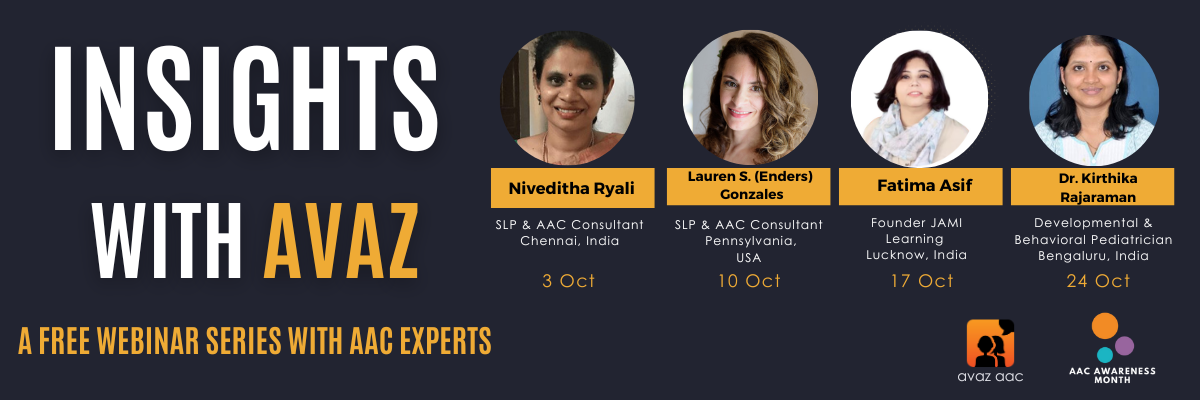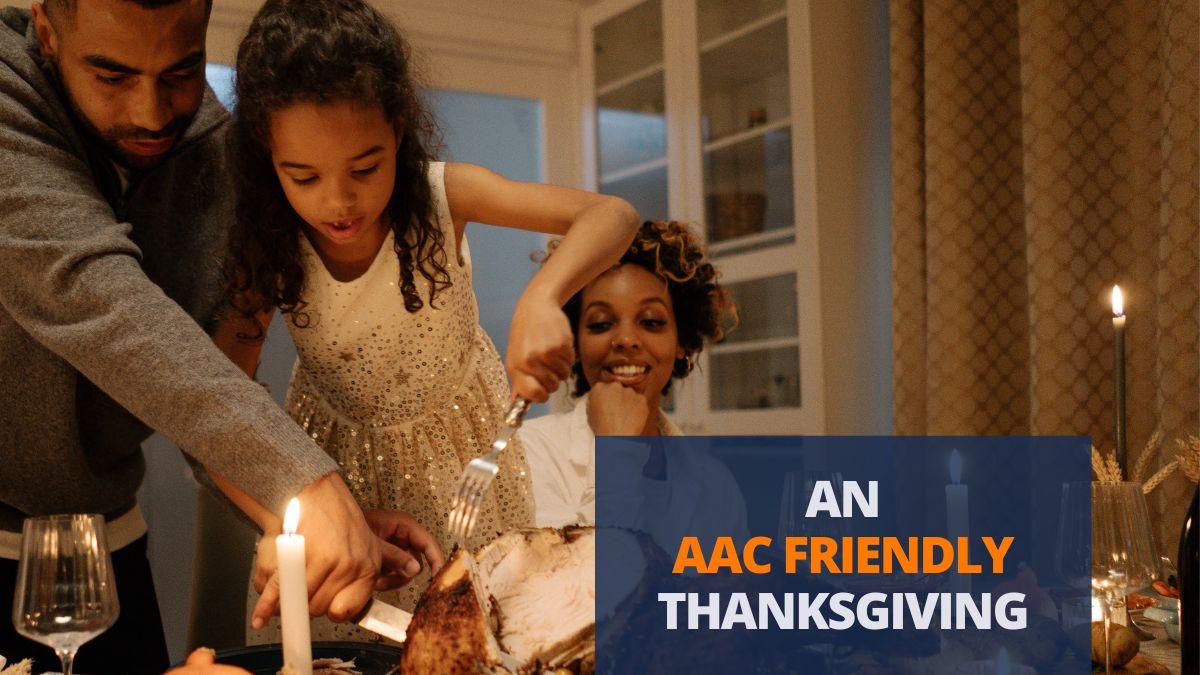When we are looking for strategies to help children learn new vocabulary, one strategy that can be considered is the focused stimulation approach. This blog tells you more about this approach and with tips on how you can begin using it with the emergent communicator in your life.
What is the Focused Stimulation Approach?
Focused Stimulation is an evidence based therapy approach. While applying it, we use general language stimulation techniques, alongside frequent, highly concentrated, repetitions of target words. We create opportunities to model the target words multiple times across a variety of contexts. In this manner, this approach facilitates comprehension and possible language production.
How Does it Work?
Here is a brief run through of how focused stimulation works.
- Communication partner provides multiple opportunities for the child to hear and use the words.
- Next, we use general language stimulation techniques like pausing offering choices and so on.
- After choosing the target words, you can identify a variety of contexts where the target words can be modeled. We are looking for contexts that will provide multiple opportunities to do so.
- The contexts should be engaging and meaningful to the child. For eg. if you are targeting verbs- get a doll, some food and self care items. Engage in play while modeling words like eat, drink, sleep, wash etc.
- Model the target words a minimum of 5 times.
- Please remember, we are NOT looking for the child to imitate the target word.


Who is it Suitable For?
This approach is mainly suitable for:
- Children who talk at single word level.
- Children who have gaps in their vocabulary.
Who Can Use This Strategy?
Research shows that apart from SLPs, parents and caregivers can also be coached to use this intervention with their young children with great impact.
Target Word Selection
The target words are the ones we focus on while applying focused stimulation. Since they are so important, we should take some care while selecting these words. Here is what you must keep in mind while making the selection(s)-
- Choose several words: Typically you select several words. Around 10-12 specific language targets what is recommended.
- Target different word types: Choose a range of nouns, verbs, adjectives, prepositions, concepts, social words etc. Research shows having a range of word types helps children to communicate a variety of needs. These include requesting, commenting, greeting etc. It also helps them to form 2 word phrases and early sentences when they are ready.
- Current speech skills: The words should be selected keeping in mind the child’s current speech production skills. Their present expressive vocabulary and developmental language norms should also be considered. And remember, the child’s interest is paramount.
Important Considerations
General language stimulation strategies involve making changes to physical and linguistic environments. This is done in order to increase opportunities for the child to hear developmentally appropriate language. Some examples of general language strategies include commenting, making choices, pausing, following their lead etc.
Focused stimulation combines use of general language facilitation strategies alongside frequent repetition of specific target words.
How to Implement This Strategy?
The best way we can use this strategy is by following the child’s lead. You can choose target words to suit the activity the child initiates.
During Play
Say the child is playing with a ball. The target words might include: up, down, throw, catch etc. If the child hears the word multiple times during play, they will understand the words. They may imitate then or use them at a later stage.
If the child is playing with play dough, appropriate target words would be open, close, roll, flatten etc.
For instance, “Let’s open the playdough box, take some dough and roll it on the floor.”
With Books and Music
Books and music are great resources for us to incorporate this approach. You can select books and music strategically for specific target words. The best kind of books for this purpose are children’s books. Especially those that have simple texts with multiple repetitions of certain words or phrases.
Here are some examples:
- Brown Bear by Eric Carle.
This book repeats “What do you see” and “I see ____” on each page. A great follow up activity after reading the book is the game of I SPY! This game will give us a chance to continue using the phrases from the book 🙂
- Goodnight Moon by Margaret Wise Brown and Clement Hurd.
This is a great book for targeting the word “goodnight”.
A follow up activity after reading the book is to encourage saying goodnight to everyone at home 🙂
Conclusion
At first it might seem difficult to use the same word multiple times in a conversation. But do not lose heart. With practice it will start becoming a habit. The more a child hears the word in different contexts, the sooner they will start to understand the meaning. Eventually they will incorporate the word(s) in their own vocabulary!
Focused stimulation may not produce instant results. But research has shown it to be very effective when used on a regular basis.
Do give this approach a try – we would be happy to answer your questions if any!
WRITTEN BY
Niveditha Ryali
Speech – Language – Swallowing Therapist
I have years of experience that comes from working in NHS(UK), special schools, hospitals and private practice. My passions are working on improving Speech, Language and Swallowing skills in children and adults. I also strive to facilitate early communication in children with complex communication needs, thereby improving parent-child bonding.






well written, thanks got the reminder